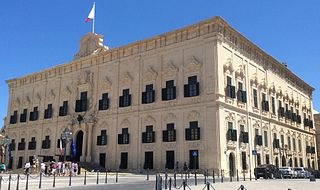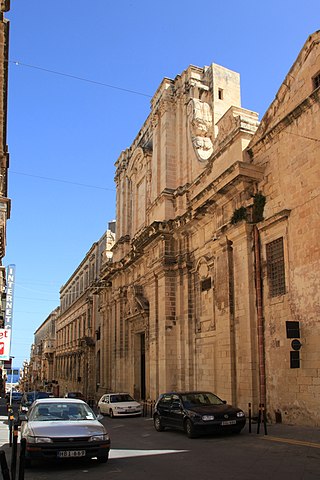Related Research Articles

António Manoel de Vilhena was a Portuguese nobleman who was the 66th Prince and Grand Master of the Order of St. John of Jerusalem from 19 June 1722 to his death in 1736. Unlike a number of the other Grand Masters, he was benevolent and popular with the Maltese people. Vilhena is mostly remembered for the founding of Floriana, the construction of Fort Manoel and the Manoel Theatre, and the renovation of the city of Mdina.

Fort Manoel is a star fort on Manoel Island in Gżira, Malta. It was built in the 18th century by the Order of Saint John, during the reign of Grand Master António Manoel de Vilhena, after whom it is named. Fort Manoel is located to the north west of Valletta, and commands Marsamxett Harbour and the anchorage of Sliema Creek. The fort is an example of Baroque architecture, and was designed with both functionality and aesthetics in mind.
Charles François de Mondion was a French architect and military engineer who was active in Hospitaller Malta in the early 18th century. He was also a member of the Order of Saint John.

Hospitaller Malta, known in Maltese history as the Knights' Period, was a de facto state which existed between 1530 and 1798 when the Mediterranean islands of Malta and Gozo were ruled by the Order of St. John of Jerusalem. It was formally a vassal state of the Kingdom of Sicily, and it came into being when Emperor Charles V granted the islands as well as the city of Tripoli in modern Libya to the Order, following the latter's loss of Rhodes in 1522. Hospitaller Tripoli was lost to the Ottoman Empire in 1551, but an Ottoman attempt to take Malta in 1565 failed.

Fort Tigné is a polygonal fort in Tigné Point, Sliema, Malta. It was built by the Order of Saint John between 1793 and 1795 to protect the entrance to Marsamxett Harbour. It is one of the oldest polygonal forts in the world. The fort, extensively altered by the British in the 19th century, remained in use by the military until 1979.

The fortifications of Malta consist of a number of walled cities, citadels, forts, towers, batteries, redoubts, entrenchments and pillboxes. The fortifications were built over hundreds of years, from around 1450 BC to the mid-20th century, and they are a result of the Maltese islands' strategic position and natural harbours, which have made them very desirable for various powers.

The fortifications of Mdina are a series of defensive walls which surround Mdina, the former capital city of Malta from antiquity to the medieval period. The city was founded as Maleth by the Phoenicians in around the 8th century BC, and it later became part of the Roman Empire under the name Melite. The ancient city was surrounded by walls, but very few remains of these have survived.

Lembi Battery, also known as Qala Lembi Battery, was an artillery battery in Sliema, Malta. It was built in 1757 by the Order of Saint John, and was considered as an outwork of Fort Manoel. The battery became obsolete with the construction of Fort Tigné in 1795, and it was briefly used as a summer residence before being demolished. In the 1870s, Cambridge Battery was built close to the site of Lembi Battery.

The Corradino Lines are a line of fortification on the Corradino Heights in Paola, Malta. They were built between 1871 and 1880 by the British. Today, the lines are partly intact and they lie in an industrial area.

The National Congress Battalions, also known as the Truppe di Campagna, was an irregular military set up in Malta just after the Maltese rebellion against French rule in September 1798. It existed for two years before being disbanded on 11 September 1800.

Michele Cachia was a Maltese architect and military engineer. He is also known for his role during the Maltese uprising of 1798–1800.

The Fortress Builders – Fortifications Interpretation Centre (FIC) is an interpretation centre about the fortifications of Malta. It is housed in a late 16th-century warehouse located near the St. Andrew's Bastion in Valletta, Malta. The centre was opened in 2013, and it aims at communicating Malta's military architecture in an interactive way.

In fortification, the term entrenchment can refer to either a secondary line of defence within a larger fortification, or an enceinte designed to provide cover for infantry, having a layout similar to a city wall but on a smaller scale. The latter usually consisted of curtain walls and bastions or redans, and was sometimes also protected by a ditch.

The French invasion of Malta was the successful invasion of the islands of Malta and Gozo, then ruled by the Order of St. John, by the French First Republic led by Napoleon Bonaparte in June 1798 as part of the Mediterranean campaign of the French Revolutionary Wars.

Domenico Cachia was a Maltese capomastro who was involved in the construction of several notable buildings, including Auberge de Castille in Valletta and St Helen's Basilica in Birkirkara. It is not certain if he was the same person as Gio Domenico Cachia, an architect who was the father of Antonio Cachia.

Antonio Cachia (1739–1813) was a Maltese architect, civil and military engineer and archaeologist who was active in the late 18th and early 19th century.
Francesco "Franco" Zerafa was a Maltese architect and donato to the Religion. In 1714, he succeeded Giovanni Barbara as Capomastro delle Opere della Religione, a post which he held until his death.

On 12 September 1634, a Hospitaller gunpowder factory in Valletta, Malta accidentally blew up, killing 22 people and causing severe damage to a number of buildings. The factory had been built at some time in the late 16th or early 17th centuries, replacing an earlier one in Fort St. Angelo in Birgu. It was located in the lower part of Valletta, close to the Slaves' Prison.

The statue of António Manoel de Vilhena is a life-sized Baroque bronze statue of António Manoel de Vilhena, a Portuguese Grand Master of the Order of St John. Commissioned in 1734 by the knight Felician de Savasse, it was sculpted by Pietro Paolo Troisi and cast by Aloisio Bouchut. In 1736 it was installed at Fort Manoel in Malta, and it was subsequently relocated a number of times. It was moved to Piazza Tesoreria in Valletta in 1858, to the entrance of The Mall gardens in Floriana in 1891, and to its present location at Pope John XXIII Square in Floriana in 1989.
Romano Fortunato Carapecchia (1666–1738) was an Italian Baroque architect who was active in Rome, Malta and Sicily. His designs helped transform Malta's capital Valletta into a Baroque city in the first few decades of the 18th century.
References
- ↑ Rix, Juliet (2010). Malta and Gozo. Bradt Travel Guides. p. 85. ISBN 9781841623122.
- ↑ Vassallo, Raymond (6 October 2013). "Joseph Spiteri". Times of Malta.
- ↑ "Dr Stephen C. Spiteri". University of Malta . Archived from the original on 14 February 2016.
- 1 2 "Brief Curriculum Vitae: Stephen C. Spiteri" (PDF). University of Malta . Archived from the original (PDF) on 3 December 2015.
- ↑ Di Puccio, Francesca (15 December 2013). "The Fortifications Interpretation Centre: a must-visit in Valletta". Malta Inside Out. Archived from the original on 4 April 2016.
- ↑ "About Us". MilitaryArchitecture.com. Archived from the original on 14 February 2016.
- ↑ Ciappara, F. (ed.) (2015). Fort Manoel: the design and construction of an 18th-century Hospitaller fort (book review). Journal of Baroque Studies, 1(3), 189-191.]